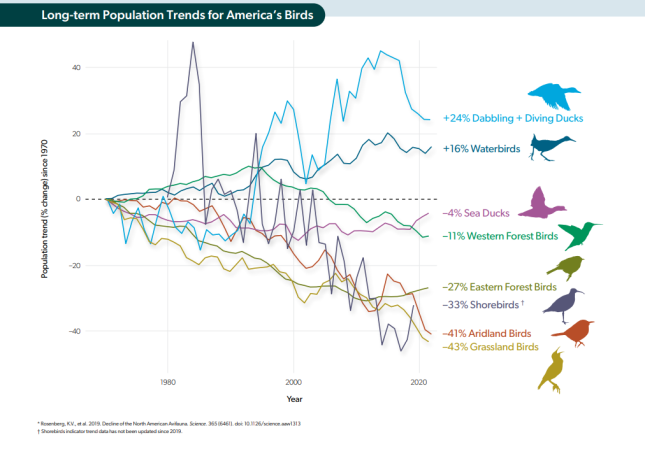State of the Birds Report 2025

5 Years After the 3 Billion Birds Lost Research, America Is Still Losing Birds
A 2019 study published in the journal Science sounded the alarm—showing a net loss of 3 billion birds in North America in the past 50 years. The 2025 State of the Birds report shows those losses are continuing, with declines among several bird trend indicators. Notably duck populations—a bright spot in past State of the Birds reports, with strong increases since 1970—have trended downward in recent years.
Conservation Works
Examples spotlighted throughout this report—from coastal restoration and conservation ranching to forest renewal and seabird translocations—show how proactive, concerted efforts and strategic investments can recover bird populations. The science is solid on how to bring birds back. Private lands conservation programs, and voluntary conservation partnerships for working lands, hold some of the best opportunities for sparking immediate turnarounds for birds.
Bird-Friendly Policies Bring Added Benefits for People, and Have Broad Support
Policies to reverse bird declines carry added benefits such as healthier working lands, cleaner water, and resilient landscapes that can withstand fires, floods, and drought. Plus birds are broadly popular—about 100 million Americans are birdwatchers, including large shares of hunters and anglers. All that birding activity stimulates the economy, with $279 billion in total economic output generated by birder expenditures.
For more information, visit: State of the Birds 2025
In the meantime, there is so much you can do to help! You may be thinking, "Well, I am just one person. How can my actions possibly matter?". Remember-individual actions add up to a movement and a movement is what affects change! Come on in and talk to us about how you can help birds. Belong to an organization? Book us to present our program "Why Birds Matter, The Threats They Face, How We Can Help". And try these implementing these everyday actions (with links for more information):
1. Drink Bird Friendly certified coffee (it's not a gimmick, we promise!). Shade-grown coffee plantations support significantly higher numbers of bird species than full sun, clear-cut coffee plantations. Forested, shade-grown coffee plantations also benefit other wildlife and the people who live there.
2. Keep your cat indoors (free roaming cats kill up to 2.4 billion birds per year).
3. Prevent window collisions (up to a billion birds are killed each year in window collisions). Use paint, decals or opaque/translucent tape to create a pattern on the outside of the window glass (with vertical stripes spaced 4 inches or less and horizontal stripes 2 inches or less) or put lightweight netting or screen several inches in front of the window.
4. Buy recycled paper products. One-third of our songbirds nest in the Boreal Forest, which is under constant threat of the timber industry. Fluffy toilet tissue purchased by many Americans stocked in virtually all supermarkets requires pulp containing long wood fibers found only in virgin timber (from live trees). When you use premium tissue, you flush down the toilet part of a tree that may have been felled solely for that purpose. Buy lumber or furniture with the Sustainable Forestry Initiative or Forest Stewardship Council logo, or buy used.
5. Avoid pesticides. Pesticides kill bugs. Birds need bugs. But pesticides also kill birds directly, so please don't use it.
6. Garden for birds by planting natives. Native plants are beneficial to songbirds. These plants support native insects, most of which are specialists rather than generalists and will not feed on non-natives. Insects are a critical food source for a variety of birds and other animals, particularly those raising young. Baby birds depend on a steady diet of insects for survival. In addition, birds depend on the berries, nectar, nuts and seeds of native trees, shrubs, grasses, and flowers.
7. Do not use rat poison. Secondary poisoning kills countless raptors, mammals and even songbirds.
8. Become engaged in the political process-vote for candidates with strong conservation records or agendas.
9. Get kids excited about birds, talk about how cool they are - their fascinating migratory feats, complex songs and calls, and well developed senses and coordination - and watch how your behavior piques an interest. Remember, today’s children will grow up to be tomorrow’s stewards of our planets! Not a “kid person”? You do not have to focus just on kids, talk up birds and nature to anyone you meet. Let them feel your enthusiasm!
10. Support conservation organizations by becoming a member and making an additional donation.
11. Add some feeders to give your birds an extra edge. In winter, the extra calories will help birds survive bitter weather, and during spring food is still scarce and hard to find. Come summer, it’s just plain adorable to see all the baby birds visiting after they have grown up on their nutritious bug diets. Goldfinches are true vegetarians and feed their young seed, consider supplementing with a goldfinch feeder. Attract hummingbirds with nectar feeders, and put oranges and nectar out for visiting orioles.
12. Put up a nest box in your yard. More than two dozen different bird species including Carolina and house wrens, chickadees and eastern screech owls use nest boxes. As more and more habitat disappears every year, birds have fewer places to nest each spring.
13. Put a birdbath in your yard to provide a year-round clean drinking and bathing water source for birds. Use a heater in winter where appropriate.

